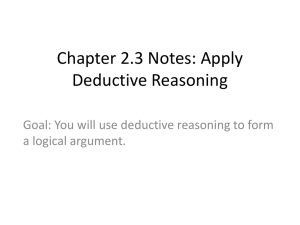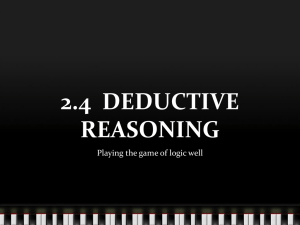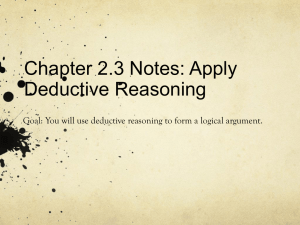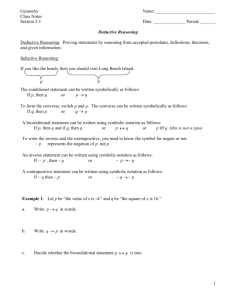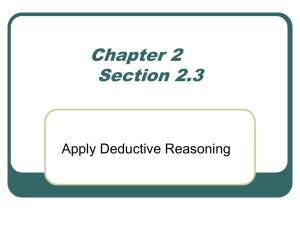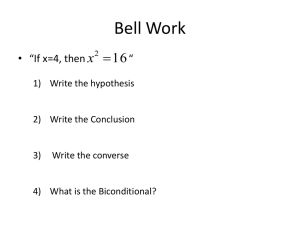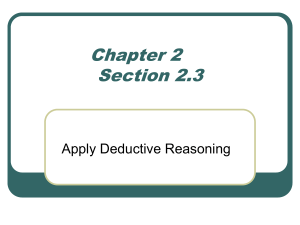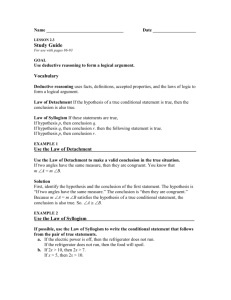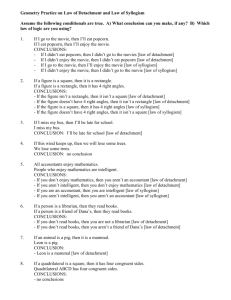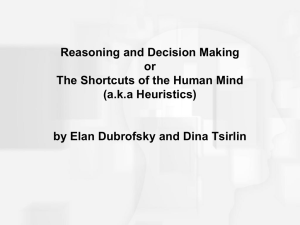Deductive Reasoning in Geometry: Logic & Proofs
advertisement
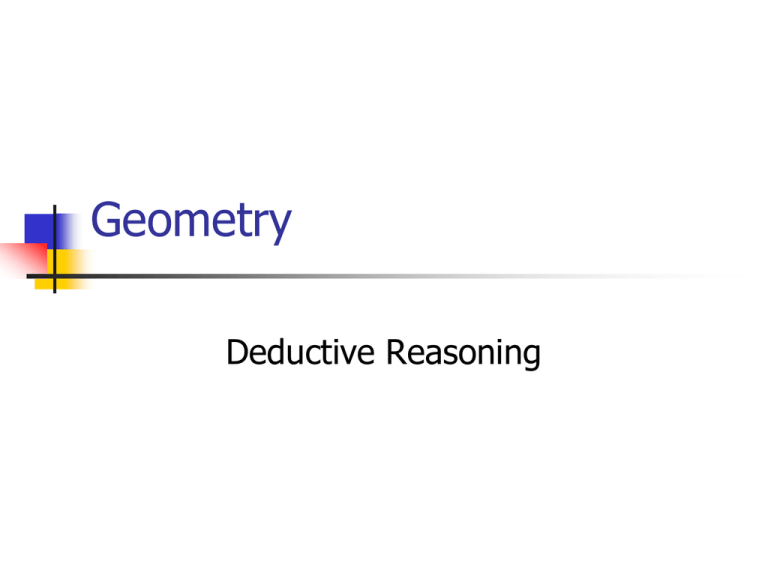
Geometry Deductive Reasoning Goals Use symbolic notation to represent logical statements. Form conclusions using logic. April 13, 2015 Mind your Ps and Qs. Conditional: If HYPOTHESIS, then CONCLUSION. Let P represent the HYPOTHESIS. Let Q represent the CONCLUSION. Then the conditional is: If P, then Q. The notation is: P Q. April 13, 2015 The symbol “” is often read as “implies”. Logical Statements Conditional: PQ Converse: QP Biconditional: PQ April 13, 2015 Example Let P be the statement: “x = 3” Let Q be the statement: “2x = 6” Write: PQ If x = 3, then 2x = 6. QP If 2x = 6, then x = 3. PQ April 13, 2015 x = 3 if and only if 2x = 6. or 2x = 6 iff x = 3. Negation Use the symbol ~. Read it as “not”. P is the statement “I like ice cream” ~P is read “Not P” ~P is the statement “I don’t like ice cream” April 13, 2015 Logical Statements Conditional: PQ Converse: QP Biconditional: PQ Inverse: ~P ~Q Contrapositive: ~Q ~P April 13, 2015 Example P: it is summer Q: it is hot ~P: It is not summer. ~P ~Q: If it is not summer, then it is not hot. Q P: If it is hot, then it is summer. April 13, 2015 Practice. Write your answers down on your paper. P: I work hard Q: I will get into college 1. What is P Q? If I work hard, then I will get into college. 2. What is ~Q ~P? If I don’t get into college, then I didn’t work hard. 3. Write ~P ~Q. If I don’t work hard, then I won’t get into college. April 13, 2015 Inductive Reasoning We use patterns and examples to make conjectures. “Find the next three numbers in this sequence…” April 13, 2015 Deductive Reasoning Uses facts, definitions and properties in a logical order to make a logical argument. Geometric proofs always use deductive reasoning. April 13, 2015 Rules of Deduction 1.Law of Detachment 2.Law of Syllogism April 13, 2015 Law of Detachment If P Q is true, and P is true, then Q is true. Example: If I get an A in Geometry, then I will get a new car. I get an A in Geometry. Conclude: I get a new car. April 13, 2015 Example Judy’s parents tell her that if she wants to go to the movies Saturday night, she has to wash the windows. Judy gets up Saturday and washes all the windows. What do we conclude? Judy can go to the movies that night. April 13, 2015 What about this? If two angles form a linear pair, then they are supplementary. A and B are supplementary. Conclusion: A and B form a linear pair. WRONG! This is saying P Q, and Q is true. This doesn’t make P true. 1 and 2 are supp, but 1 not a linear pair. 2 April 13, 2015 Commonly seen errors. “If there is a storm, then the power will go out”, said Marco. Suddenly the power goes out, leaving everyone in the dark. “Gee, I guess there is a storm!”, exclaims Marco. “No, you retard: you forgot to pay the electric bill”, said his sister. Just because the conclusion is true, does not mean that the hypothesis is true. April 13, 2015 Law of Detachment (again) P Q is true. PQ P is true. P Conclusion: Q is true. Q April 13, 2015 Law of Syllogism In symbols: If P Q is true, and Q R is true, then P R is also true. Example: If Sam gets an A in math, then he can buy a car. If he can buy a car, then he will be popular. Conclusion: If Sam gets an A in math, then he will be popular. April 13, 2015 Example Write the conclusion that we can make based on the law of syllogism. If I watch too much TV, then I will be dumb. If I am dumb, then I won’t get an A in math. Conclusion: If I watch too much TV, then I won’t get an A in math. April 13, 2015 Extending a Syllogism If I wake up, then I can get dressed. If I get dressed, then I can go to school. If I go to school, then I can walk to class. If I walk to class, then I will meet the school bully. If I meet the school bully, then I will get in a fight. If I get in a fight, then I will be suspended. If I get suspended, then I will stay home. If I stay home, then I will go to sleep. Conclusion: If I wake up, then I will go to sleep. April 13, 2015 So where’s the math? If angles form a linear pair, then they are supplementary. If angles are supplementary, then their sum is 180°. Conclusion: If angles form a linear pair, then their sum is 180°. We have just proved a theorem! April 13, 2015 Syllogism (again) Jump from beginning to the end. If P Q, and Q R, then P R These are the same means… April 13, 2015 Putting Two Laws Together If Jake gets a job, then he can pay for football camp. If he goes to football camp, then he will make the varsity team. If he makes varsity, then he will be Homecoming King. Jake gets a job. Conclusion: Jake will be Homecoming King. April 13, 2015 April 13, 2015 Practice 4. Determine if statement (3) follows from statements (1) and (2). If so, what Law was used? (1) If you eat sushi, then you will get sick. (2) You eat sushi. (3) You get sick. April 13, 2015 Yes this follows, by Law of Detachment. Practice 5. Determine if statement (3) follows from statements (1) and (2). If so, what Law was used? (1) If x = 10, then y = 20 (2) If y = 20, then z = 25 (3) If x = 10, then z = 25 Yes this follows by the Law of Syllogism. April 13, 2015 Practice 6. Determine if statement (3) follows from statements (1) and (2). If so, what Law was used? (1) If you are a lawyer, then you will be rich. (2) You are rich. (3) Then you are a lawyer No, this doesn’t follow. The argument is invalid. You could get rich another way. April 13, 2015 Last Practice Q P 7. If Jim talks back to his boss, then he will lose his job. If he losesQhis job, he will have to sell his R car. Jim talks back to the boss. P What’s the conclusion? Jim has to sell his car. P Q, Q R PR means P R P is True (Syllogism) R is True April 13, 2015 (Detachment) Practice Problems April 13, 2015
